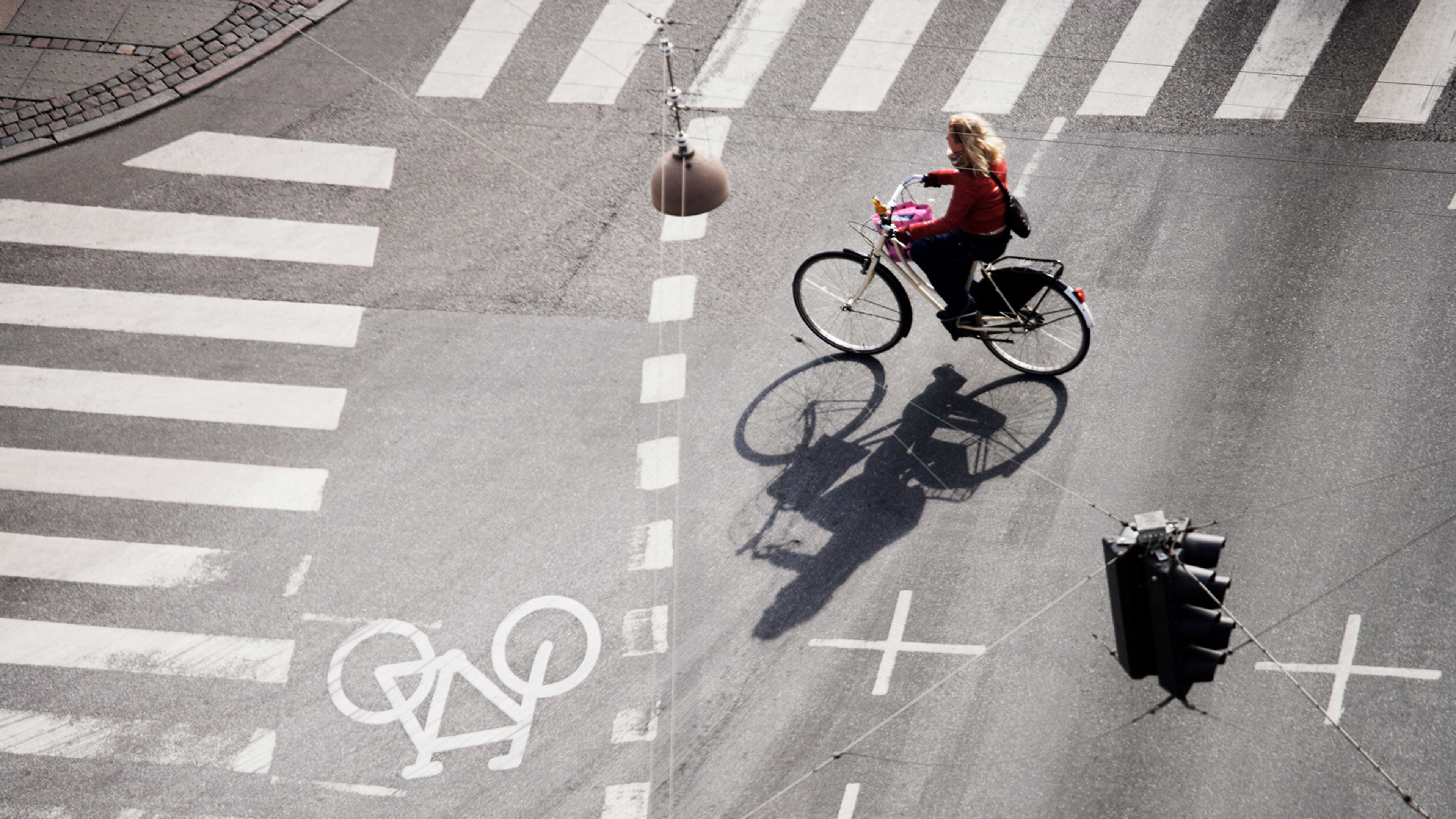Michelle Cook bought her first bike on something of a dare. Around six years ago, she was living in Needham, a hilly town on the outskirts of Boston, and a friend of her challenged her to take on the steep streets on a bike. She was around 40 at the time, and hadn’t been on a bike since she was a child growing up on Cape Cod, but she found an old bicycle at a garage sale for $25, cleaned it up, and took it out on the road.
She didn’t expect to get hooked, but she did, and began biking every day. “As I started biking, I realized that as a woman–particularly as a black woman–there weren’t many of us that bike,” she says. “Biking is one of the things that I do that people consider something that we don’t do.” The more she rode, the less she understood why that is. “It’s a great form of exercise, it’s fun, it’s way faster to get somewhere than waiting for a bus or a train,” she says. And biking, Cook adds, just made her feel good. She’s dealt with depression for much of her adult life, but on a bike, she says, she feels strong. A couple years ago, she founded the organization Roxbury Rides to encourage women of color to bike more, and to advocate for better infrastructure and education around active transit and public space.
I’m a woman cyclist myself–I bike every day in New York City–and for this article, I spoke to women in cities across the country. All have different experiences, different commutes, different bikes, different stories about how they first got into it, but what I heard described over and over again, and have sensed every day myself since I started riding, was the feeling of empowerment that cycling produces. It’s something about being able to independently transport yourself around your city on the strength of your own body. Something about learning the streets and routes and neighborhoods with an intimacy inaccessible to those passing by in a car. And something about being a part of a small minority of people who are doing a thing we’ve all been told we shouldn’t, or couldn’t, do.
Across the U.S., cycling as a valid form of sustainable transit is experiencing something of a renaissance. As cities face down issues of growing traffic congestion and systemic public transit failures, advocates and environmentalists are pointing to the bicycle–a mode of transit that originated in the late 19th century–as a zero-carbon, efficient way of making trips around a city, particularly trips under three miles long, of which around 72% are currently made by car. As cities across the world scramble for ways to limit their carbon footprint in the face of rampant climate change, interventions like the shift to electric vehicles and improvements to public-transit infrastructure will be crucial. But with another 2.5 billion people slated to move into urban environments by 2050, we can’t overlook the issue of street congestion–and the fact that approximately six bikes can fit into the space taken up by a single car.
In order for cycling to become a truly competitive mode of urban transit, we also need to address its issue of gender inequity. Fewer than one in four trips on a bike are currently made by women. In recent years, data from ever-more-popular bike share programs has backed this up: Motivate, the company that oversees bike-share programs in New York, Boston, Chicago, and the Bay Area has found that just 34% of annual bike-share members are women, and together, they take only 24% of trips made on the systems. And even though the bike share boom has undoubtedly helped increase the sheer number of cyclists on city streets–Transportation Alternatives, New York City’s main bike and pedestrian advocacy nonprofit, has found that the number of daily cyclists in New York has risen from 15,000 in 2000 to 45,000 in 2015– the gender gap has held steady.
In recent years, advocacy organizations like the New York City-based Women’s Empowerment Through Bicycles (WE Bike NYC), Women Bike Chicago, and Cook’s Roxbury Rides have sprung up to address this gap by encouraging more women to bike. Motivate has been working with cities in which it operates bike-share programs to provide data around ridership. “One of the big benefits bike-share programs offer cities and policymakers and to the cycling community is insights into who is biking, where they’re biking, and when, which has traditionally been hard information to come by,” says Julie Wood, VP of communications at Motivate. Now that the data is accessible and incontrovertible, cities, advocates, the bike community, and individuals alike have some work to do to figure out why the gender gap exists–and how to close it.
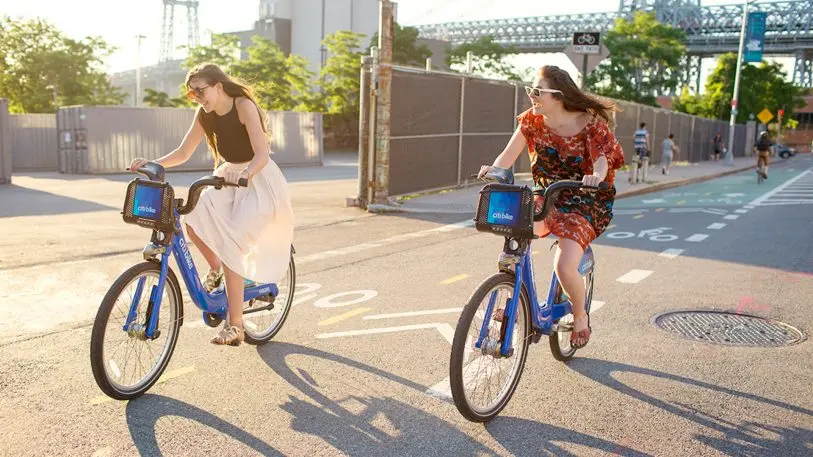
The Cycling Gender Gap: A History
There are very real reasons that all people–not just women–may be reluctant to bike in a city, and the main one is the built environment of the city itself. In the majority of U.S cities, the street design prioritizes cars over cyclists and pedestrians. Places like Copenhagen and Amsterdam, considered the gold standard for safe and user-friendly bike infrastructure, can point to a centuries-long history of public-space usage before the advent of the car. While both places, and many other European cities, briefly swung toward car culture in the post-World War II years, building parking lots and consigning their streets to automobiles, they have, since the 1970s, worked to correct that brief deviation by spearheading car-free weekend days and other cyclist and pedestrian-friendly measures. Today, they’re home to a robust cycling infrastructure that places the bike on equal–or sometimes higher–footing than the car.
The boom of U.S. cities like New York, however, co-originated with the invention of the car. “American cities came to be built almost exclusively for the automobile,” says James Longhurst, associate professor at University of Wisconsin, La Crosse, and author of Bike Battles: A History of Sharing the American Road. When cars started becoming popular in the early 1900s, the layout and design of U.S. cities was still in flux. Around that time, Fifth Avenue in New York was but a glimmer of the commercial corridor it is today, and it was relatively easy for the city, in 1908, to gut pedestrian space and widen the street for cars.
By the time the environmentalists of the 1960s and ’70s began to warn about the automobile and the pollution it produces, Longhurst says, there was virtually no space on urban roads for bicycles, which, he adds, had been relegated in the American consciousness to something of a toy, rather than a mode of transit. Those same environmentalists, Longhurst says, originated in the late ’60s what became known as the “bike boom,” where they began to push for cycling as a practical way of getting around cities. But that boom, he adds, “really didn’t do much to transform American streets.” While a handful of advocates rallied for new infrastructure–mainly bike lanes–to support the growing number of cyclists, the bike boom tactic that won out in the end was something called “vehicular cycling“–the idea that cyclists should integrate themselves into urban traffic by essentially acting like cars. “What they were proposing didn’t cost cities anything,” Longhurst says. Almost all that changed was the addition of those little rectangular signs that say “bike route,” but do not correspond to any relevant infrastructure.
“So from the 1970s on, in most American cities, to ride your bicycle means to be confident enough and self-possessed enough and privileged enough to ride out into the road and demand your space,” Longhurst says.
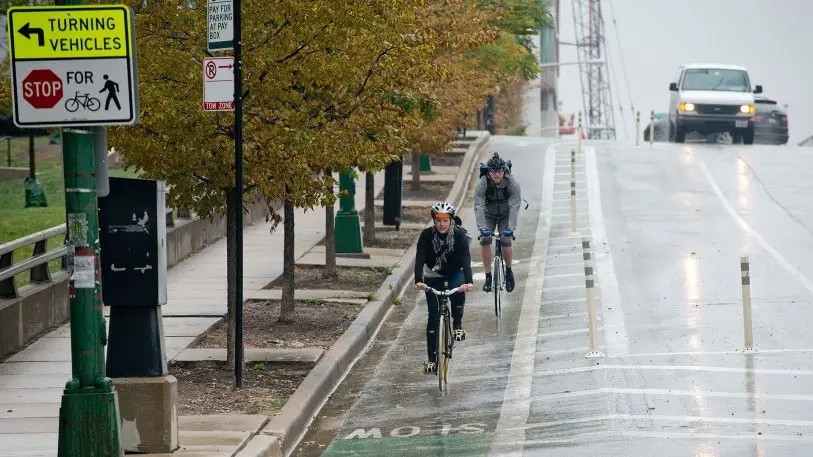
If You Build It, They Will Bike
Around a decade ago, cities across the U.S. began to resuscitate the logic of the bike-lane advocates who were drowned out by the vehicular cyclists of the 1970s. New York City, for instance, has added around 54 miles of bike lanes to its 6,000 miles of roads every year since 2007; Chicago has added 27 miles to its 4,000 miles of road each year since 2011. There’s clearly room to do more, and the benefits of the new lanes are already apparent. In both cities–and in many other cities that have advanced similar infrastructure–death and injury rates have dropped by around half.
While these improvements are a step in the right direction, TransAlt has found that “the growth in cycling has leapfrogged the infrastructure.” In essence, bike infrastructure networks are still neither robust enough nor connected enough to ensure that commuters can feel safe along the length of their ride. “In order for cycling to feel safe in this city, and in all cities, there need to be serious changes in how we build and develop bike infrastructure,” says Rosemary Bolich, a New York-based cyclist. And when there’s a notable lack of quality infrastructure, it’s reflected most clearly in the number of female cyclists traversing the area.
In Midtown Manhattan, for instance, there is a noticeable lack of crosstown bike lanes on the streets north of 23rd all the way up to Central Park at 59th, and the handful of bike lanes on the north-south avenues are often clogged with cars or other obstructions. The New York City Department of Transportation (NYC DOT) worked with Motivate to map data on Citi Bike usage in Midtown, and found that the vast majority of Citi Bike stations in that swath of the city draw less than the average 24% of female usage. Stations south of 23rd, where bike lanes are more plentiful, see rates of female usage at equal to or over 24%–and are generally less congested with car and truck traffic. “If you see high numbers of women cycling, you are doing something right,” says Mikael Colville-Andersen, urban design expert and CEO of Copenhagenize Design Co., a Danish consultancy specializing in bike infrastructure. So significant is the percent of women ridership, he adds, that the gender split is something his firm measures in the Copenhagenize Index, which tracks the progress of cities on developing bike infrastructure.
Polly Trottenberg, NYC DOT commissioner, has watched the cycling boom take off and spread rapidly across New York, and across cities in the U.S. “We’re looking for ways to make the city more accessible and more sustainable, and that means switching to sustainable modes of transit: bikes, buses, pedestrians,” Trottenberg tells Fast Company, though she acknowledges that New York and other American cities have a long way to go before they reach “full Copenhagen status” in terms of both bike safety and gender equity–in the Danish city, over 50% of people commute by bike, and 55% of regular cyclists are women.
The key to Copenhagen’s success in both raising the number of overall bike commuting and closing the gender gap, Colville-Andersen says, “is infrastructure. There is no chicken or egg.” A robust network of interconnected bike lanes all across a city will lay the necessary groundwork to get more people cycling–and by adding bike lanes to lower-income neighborhoods, often underserved by public transportation, cities have a real opportunity to advance socioeconomic equity by increasing mobility and access.
From there, there are a number of smaller interventions cities can adopt to make cycling safer, and the most efficient way to get around, he adds. Design tweaks like “the green wave”–which ensures that on most major arteries into the city center, cyclists never hit a red light and can bike continuously without putting a foot down–increase both speed and safety. Small additions like trash cans tilted toward cyclists along bike lanes, and railings or footrests for cyclists, send the signal that cities are concerned with designing for bikers, Colville-Andersen adds.
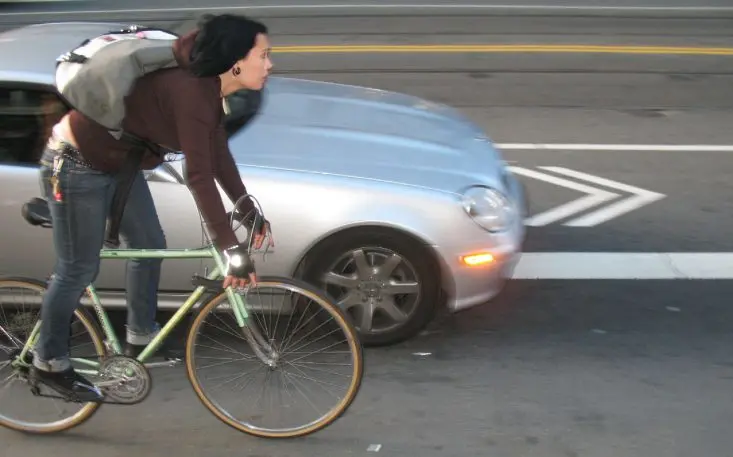
The Stigma of Biking
Copenhagenize Design Co. is working closely with cities around the world to develop these infrastructural adjustments to support cycling. But we have yet to truly shake the hypermasculine association with biking that coalesced around the advent of vehicular cycling in the 1970s.
Vehicular cycling, as Longhurst says, essentially necessitates being unafraid to take up space; to cut people (in this case, drivers) off; to get vocal and at times get angry. These are all things that women are taught not to do, and the consequences of deviating from these expectations ramify–as the backlash against women speaking out about harassment, for instance, reminds us–across a multitude of public and cultural spaces.
There’s an ambient sense that cycling, even safely contained in a network of bike lanes, is antithetical to femininity. In 2014, the writer and bike advocate Elly Blue ignited a Twitter firestorm when she asked the question: “What does “feminine” mean? I’m serious. It keeps coming up in the context of things women can do to feel that way on a bike, + I’m confused.” For one, as cyclist Melody Hoffman commented in a CityLab article in response to Blue’s question: “Women are expected to show up to places already presentable.” In the summer, as a cyclist, you often arrive places dripping in sweat. In the winter, you have to peel off what feels like more layers than an onion. The aesthetics of cycling alone pose a formidable barrier to women’s participation. Angela Azzolino, a lifelong New York City cyclist and founder of the nonprofit Get Women Cycling, whose mission is evident in the name, runs an annual campaign, #ShowMeHelmetHair, in which women cyclists and hairstylists shared tips for how to prep your hair to survive a long ride under a helmet–or just to rock the slightly feral mess that emerges once you take the helmet off. “It’s a way to start dialogues and get people engaged in this conversation,” Azzolino says.
Because, she adds, “there’s a lot to address in this space.” Breaking down the stigma around being a woman cyclist goes hand-in-hand with the much larger societal project of breaking down the idea of what it means to be an “ideal” woman. And perhaps, when talking about biking, nowhere is the need to do so more evident than in the different ways our society–whether consciously or not–talks to men and women cyclists.
At least once a week, I will pull up to a red light on my bike and someone–usually an older man–will say to me: “I hope you’re being careful,” accompanied by some shake of the head. If not that, it’s someone asking me: “Aren’t you scared?” I have yet to meet a male cyclist who’s subject to the same constant questioning; most of the women I spoke with share my experience. Last year in the New York Times, Caroline Paul, a retired firefighter, wrote a piece called “Why Do We Teach Girls That It’s Cute To Be Scared?” in which she describes facing the exact same questions and notes of caution about her choice of profession (just around 5% of firefighters are women).
Conditioning girls to be scared, to avoid activities deemed challenging or intimidating, Paul says, is something that begins in childhood, and carries through to adulthood. Watching a woman do something that she is not supposed to do–to echo Cook’s sentiment– or something that is unusual, that is daring or risky, sets off our collective alarm bells: Someone has slipped through the safety net, has stepped out of line. Is it not our job to usher her back to safety?
If “safety” in this sense means encouraging women to stick with the status quo–to refuse an activity because it has been categorized as one that requires a certain amount of guts–then that is absolutely not our job. As Paul writes: “By cautioning girls away from these experiences, we are not protecting them. We are failing to prepare them for life.” But that is not to say that we should just toss a helmet or a pair of cycling shorts at women and say, “Time to get on a bike!” There needs to be a concerted reckoning with why we caution women cyclists and encourage men. Moreover, there needs to be a concerted effort to build citywide bike systems that are less a cause for caution than the ones we currently have.
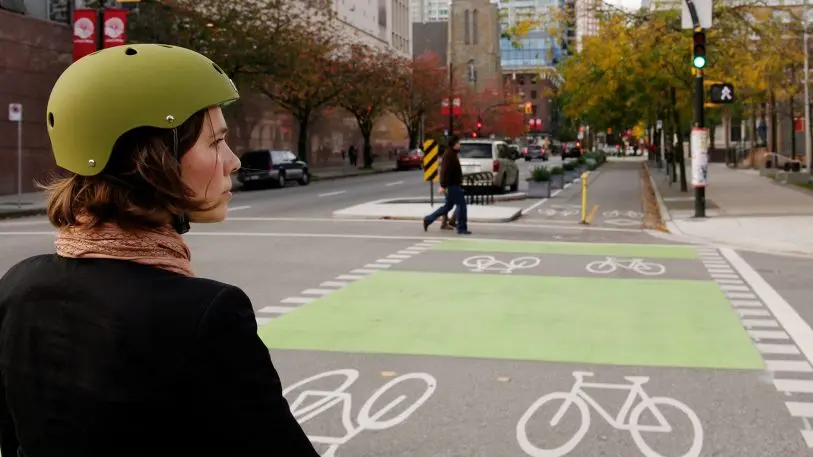
Creating a Culture Shift
As cities and designers tackle the infrastructure, advocates within the bike community are working to close the gender gap in urban cycling from the inside out.
In addition to launching campaigns like #ShowMeHelmetHair, Azzolino’s organization, Get Women Cycling, is working close the gender gap in the bike retail and repair sectors, which are historically male-dominated. Azzolino, who has spent some time as a service floor mechanic at a Brooklyn bike shop, has witnessed both surprise at her presence, and the larger discrepancies between the way men and women are treated in shops. “Women tend to go into shops with a preconception of how things are going to be, and the preconception is that they are not going to be heard, or I’m not going to be able to find what I need,” Azzolino says. “And bike shops aren’t savvy enough to turn that around.” Get Women Cycling, Azzolino says, is growing a network of partnerships with New York-based bike shops to “act as the interpreter” between female clients and predominantly male mechanics and salespeople by educating the latter on how to better target their services to women, and to create an overall more welcoming environment. A recent uptick in the number of female and gender-nonconforming-focused bike repair classes also feeds into Azzolino’s work.
But really, “the thing that makes biking better for women is more women biking,” Wood says. Bolich agrees: “There is safety and strength in numbers,” she says. Bolich is a volunteer with WE Bike NYC, an organization that hosts rides and events for women and gender nonconforming people. “What we hear from a lot of people who participate in our rides is it makes them feel better,” Bolich says. “In some ways, for people who are new to riding in a city, it helps to sort of practice in a group, before setting out alone.” The cycling world, like the rest of the world, she adds, is very male-dominated, and there’s a part of it that’s dismissive toward people–especially new cyclists–who may be nervous about riding in traffic, or on unprotected bike lanes.
That attitude–layered on top of incomplete infrastructural systems–sets the barrier for entry into the urban cycling world way too high. Bike-share programs, Wood says, have been an effective way to lower that bar by enabling people to take shorter trips and not have to worry about maintaining and caring for their own bike. “It’s sort of a stepping stone that makes biking more accessible,” she says. But still, Motivate recognizes that just planting bike-share stations around the city is not enough to close the gender gap. Every September, the bike-share company hosts Women’s Bike Month, in which it highlights female bike commuters in various cities, offers free bike share passes, and hosts group rides. “It’s all about putting a spotlight on the need to break down these barriers to entry and encourage more women to bike,” Wood says.
It’s not a thing that can be forced, and it’s not for everybody. If someone truly does not want to ride and doesn’t feel comfortable doing so, Bolich says, they shouldn’t be pressured to do so. But for many people, like Cook, who just decide to try it, it might click. “I can’t even describe the feeling–when you bike, it’s like you go into it thinking you can’t do something, but then you can,” she says. In October, Cook rode in a 25-mile fundraiser for her organization. It was the longest ride she had ever tackled, and it was hilly. “I hate hills and inclines, and by mile 11, I was ready to quit,” she says. Instead, she pedaled through. “The fact that I know I found something–biking–that’s good for my mind, and gives me this indescribable feeling of happiness and euphoria, that did it for me,” she says.
Instead of asking women cyclists, “Aren’t you scared?” what if what we asked them was: “How does biking make you feel?”
Recognize your brand’s excellence by applying to this year’s Brands That Matter Awards before the early-rate deadline, May 3.
